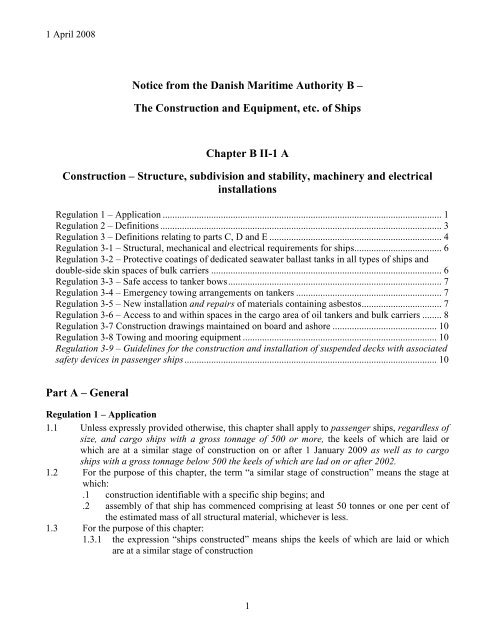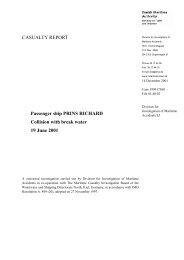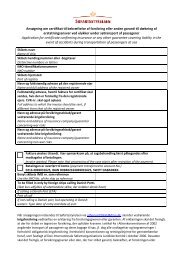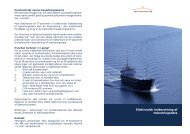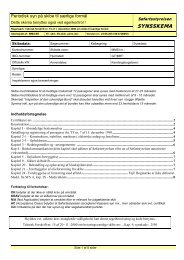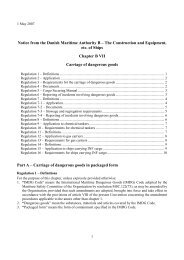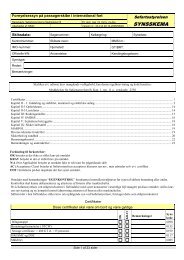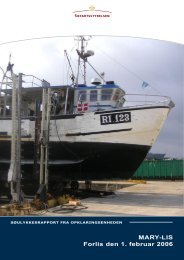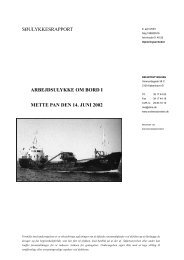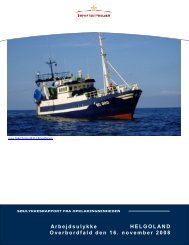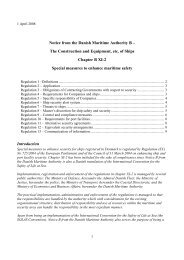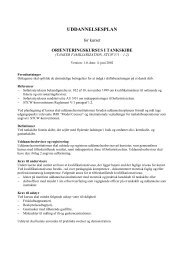Notice from the Danish Maritime Authority B
Notice from the Danish Maritime Authority B
Notice from the Danish Maritime Authority B
You also want an ePaper? Increase the reach of your titles
YUMPU automatically turns print PDFs into web optimized ePapers that Google loves.
1 April 2008<br />
<strong>Notice</strong> <strong>from</strong> <strong>the</strong> <strong>Danish</strong> <strong>Maritime</strong> <strong>Authority</strong> B –<br />
The Construction and Equipment, etc. of Ships<br />
Chapter B II-1 A<br />
Construction – Structure, subdivision and stability, machinery and electrical<br />
installations<br />
Regulation 1 – Application ................................................................................................................... 1<br />
Regulation 2 – Definitions .................................................................................................................... 3<br />
Regulation 3 – Definitions relating to parts C, D and E ....................................................................... 4<br />
Regulation 3-1 – Structural, mechanical and electrical requirements for ships.................................... 6<br />
Regulation 3-2 – Protective coatings of dedicated seawater ballast tanks in all types of ships and<br />
double-side skin spaces of bulk carriers ............................................................................................... 6<br />
Regulation 3-3 – Safe access to tanker bows........................................................................................ 7<br />
Regulation 3-4 – Emergency towing arrangements on tankers ............................................................ 7<br />
Regulation 3-5 – New installation and repairs of materials containing asbestos................................. 7<br />
Regulation 3-6 – Access to and within spaces in <strong>the</strong> cargo area of oil tankers and bulk carriers ........ 8<br />
Regulation 3-7 Construction drawings maintained on board and ashore ........................................... 10<br />
Regulation 3-8 Towing and mooring equipment ................................................................................ 10<br />
Regulation 3-9 – Guidelines for <strong>the</strong> construction and installation of suspended decks with associated<br />
safety devices in passenger ships........................................................................................................ 10<br />
Part A – General<br />
Regulation 1 – Application<br />
1.1 Unless expressly provided o<strong>the</strong>rwise, this chapter shall apply to passenger ships, regardless of<br />
size, and cargo ships with a gross tonnage of 500 or more, <strong>the</strong> keels of which are laid or<br />
which are at a similar stage of construction on or after 1 January 2009 as well as to cargo<br />
ships with a gross tonnage below 500 <strong>the</strong> keels of which are lad on or after 2002.<br />
1.2 For <strong>the</strong> purpose of this chapter, <strong>the</strong> term “a similar stage of construction” means <strong>the</strong> stage at<br />
which:<br />
.1 construction identifiable with a specific ship begins; and<br />
.2 assembly of that ship has commenced comprising at least 50 tonnes or one per cent of<br />
<strong>the</strong> estimated mass of all structural material, whichever is less.<br />
1.3 For <strong>the</strong> purpose of this chapter:<br />
1.3.1 <strong>the</strong> expression “ships constructed” means ships <strong>the</strong> keels of which are laid or which<br />
are at a similar stage of construction<br />
1
1.3.2 <strong>the</strong> expression “all ships” means passenger ships, regardless of size, and cargo ships<br />
with a gross tonnage of 500 or more constructed before, on or after 1 January 2009 as<br />
well as cargo ships with a gross tonnage below 500 constructed on or after 1 January<br />
2002;<br />
1.3.3 a cargo ship, whenever built, which is converted to a passenger ship shall be treated as<br />
a passenger ship constructed on <strong>the</strong> date on which such a conversion commences.<br />
1.3.4 <strong>the</strong> expression “alternations and modifications of major character” means, in <strong>the</strong><br />
context of cargo ship subdivision and stability, any modification to <strong>the</strong> construction<br />
which affects <strong>the</strong> level of subdivision of that ship. WWhere a cargo ship is subject to<br />
suchs modification, it shall be demonstrated that <strong>the</strong> A/R ratio calculated for <strong>the</strong> ship<br />
after suchs modification is not less than <strong>the</strong> A/R before <strong>the</strong> modification. However, in<br />
<strong>the</strong>se cases where <strong>the</strong> ship’s A/R ratio before modification is equal to or greater than<br />
unity, it is only necessary that <strong>the</strong> ship after modification has an A value which is not<br />
less than R, calculated for <strong>the</strong> modified ship.<br />
2. Unless expressly provided o<strong>the</strong>rwise, for passenger ships, regardless of size, and cargo ships with a<br />
gross tonnage of 500 or more constructed before 1 January 2009, <strong>the</strong> Administration shall ensure<br />
that <strong>the</strong> requirements which are applicable under chapter II-1 of <strong>the</strong> International Convention for<br />
<strong>the</strong> Safety of Life at Sea, 1974, as amended by resolutions MSC.1(XLV), MSC.6(48), MSC.11(55),<br />
MSC.12(56), MSC.13(57), MSC.19(58), MSC.26(60), MSC.27(61), Resolution 1 of <strong>the</strong> 1995<br />
SOLAS Conference, MSC.47(66), MSC.57(67), MSC.65(68), MSC.69(69), MSC.99(73),<br />
MSC.134(76), MSC.151(78) and MSC.170(79) are complied with.<br />
3. All ships which undergo repairs, alterations, modifications and outfitting related <strong>the</strong>reto shall<br />
continue to comply with at least <strong>the</strong> requirements previously applicable to <strong>the</strong>se ships. Such ships, if<br />
constructed before <strong>the</strong> date on which any relevant amendments enter into force, shall, as a rule,<br />
comply with <strong>the</strong> requirements for ships constructed on or after that date to at least <strong>the</strong> same extent<br />
as <strong>the</strong>y did before undergoing such repairs, alterations, modifications or outfitting. Repairs,<br />
alterations and modifications of a major character and outfitting related <strong>the</strong>reto shall meet <strong>the</strong><br />
requirements for ships constructed on or after <strong>the</strong> date on which any relevant amendments enter into<br />
force in so far as <strong>the</strong> Administration deems reasonable and practicable.<br />
4. The Administration of a State may, if it considers that <strong>the</strong> sheltered nature and conditions of <strong>the</strong><br />
voyage are such as to render <strong>the</strong> application of any specific requirements of this chapter<br />
unreasonable or unnecessary, exempt <strong>from</strong> those requirements individual ships or classes of ships<br />
entitled to fly <strong>the</strong> flag of that State which, in <strong>the</strong> course of <strong>the</strong>ir voyage, do not proceed more than<br />
20 miles <strong>from</strong> <strong>the</strong> nearest land.<br />
5. In <strong>the</strong> case of passenger ships which are employed in special trades for <strong>the</strong> carriage of large<br />
numbers of special trade passengers, such as <strong>the</strong> pilgrim trade, <strong>the</strong> Administration of <strong>the</strong> State<br />
whose flag such ships are entitled to fly, if satisfied that it is impracticable to enforce compliance<br />
with <strong>the</strong> requirements of this chapter, may exempt such ships <strong>from</strong> those requirements, provided<br />
that <strong>the</strong>y comply fully with <strong>the</strong> provisions of:<br />
5.1. <strong>the</strong> rules annexed to <strong>the</strong> Special Trade Passenger Ships Agreement, 1971; and<br />
5.2. <strong>the</strong> rules annexed to <strong>the</strong> Protocol on Space Requirements for Special Trade Passenger Ships,<br />
1973.<br />
2
Regulation 2 – Definitions<br />
For <strong>the</strong> purpose of this chapter, unless expressly provided o<strong>the</strong>rwise:<br />
1. Subdivision length (L s ) of <strong>the</strong> ship is <strong>the</strong> greatest projected moulded length of that part of <strong>the</strong> ship<br />
at or below deck or decks limiting <strong>the</strong> vertical extent extent of flooding with <strong>the</strong> ship at <strong>the</strong><br />
deepest subdivision draught.<br />
2. Mid-length is <strong>the</strong> mid-point of <strong>the</strong> subdivision length of <strong>the</strong> ship<br />
3. Aft terminal is <strong>the</strong> aft limit of <strong>the</strong> subdivision length.<br />
4. Forward terminal is <strong>the</strong> forward limit of <strong>the</strong> subdivision length.<br />
5. Length (L) is <strong>the</strong> length as defined in <strong>the</strong> International Convention on Load Lines in force.<br />
6. Freeboard deck is <strong>the</strong> deck as defined in <strong>the</strong> International Convention on Load Lines in force.<br />
7. Forward perpendicular is <strong>the</strong> forward perpendicular as defined in <strong>the</strong> International Convention on<br />
Load Lines in force.<br />
8. Breadth (B) is <strong>the</strong> greatest moulded breadth of <strong>the</strong> ship at or below <strong>the</strong> deepest subdivision<br />
draught.<br />
9. Draught(d) is <strong>the</strong> vertical distance <strong>from</strong> <strong>the</strong> keel-line at mid-length to <strong>the</strong> waterline in question.<br />
10. Deepest subdivision draught (d s ) is <strong>the</strong> waterline which corresponds to <strong>the</strong> summer load line of<br />
<strong>the</strong> ship.<br />
11. Light service draught(d l ) is <strong>the</strong> service draught corresponding to <strong>the</strong> lightest anticipated loading<br />
and associated tankage, including, however, such ballast as may be necessary for stability and/or<br />
immersion. Passenger ships should include <strong>the</strong> full complement of passengers and crew on board.<br />
12. Partial subdivision draught (d p ) is <strong>the</strong> light service draught plus 60% of <strong>the</strong> difference between<br />
<strong>the</strong> light service draught and <strong>the</strong> deepest subdivision draught.<br />
13. Trim is <strong>the</strong> difference between <strong>the</strong> draught forward and <strong>the</strong> draught aft, where <strong>the</strong> draughts are<br />
measured at <strong>the</strong> forward and aft terminals respectively, disregarding any rake of keel.<br />
14. Permeability (µ) of a space is <strong>the</strong> proportion of <strong>the</strong> immersed volume of that space which can be<br />
occupied by water.<br />
15. Machinery spaces are spaces between <strong>the</strong> watertight boundaries of a space containing <strong>the</strong> main<br />
and auxiliary propulsion machinery, including boilers, generators and electric motors primarily<br />
intended for propulsion. In <strong>the</strong> case of unusual arrangements, <strong>the</strong> Administration may define <strong>the</strong><br />
limits of <strong>the</strong> machinery spaces.<br />
16. Wea<strong>the</strong>rtight means that in any sea conditions water will not penetrate into <strong>the</strong> ship.<br />
17. Watertight means having scantlings and arrangements capable of preventing <strong>the</strong> passage of water<br />
in any direction under <strong>the</strong> head of water likely to occur in intact and damaged conditions. In <strong>the</strong><br />
damaged condition, <strong>the</strong> head of water is to be considered in <strong>the</strong> worst situation at equilibrium,<br />
including intermediate stages of flooding.<br />
18. Design pressure means <strong>the</strong> hydrostatic pressure for which each structure or appliance assumed<br />
watertight in <strong>the</strong> intact and damage stability calculations is designed to withstand.<br />
19. Bulkhead deck in a passenger ship means <strong>the</strong> uppermost deck at any point in <strong>the</strong> subdivision<br />
length (L s ) to which <strong>the</strong> main bulkheads and <strong>the</strong> ship’s shell are carried watertight and <strong>the</strong><br />
lowermost deck <strong>from</strong> which passenger and crew evacuation will not be impeded by water in any<br />
stage of flooding for damage cases defined in regulation 8 and in part B-2 of this chapter. The<br />
bulkhead deck may be a stepped deck. In a cargo ship <strong>the</strong> freeboard deck may be taken as <strong>the</strong><br />
bulkhead deck.<br />
3
20. Deadweight is <strong>the</strong> difference in tonnes between <strong>the</strong> displacement of a ship in water of a specific<br />
gravity of 1.025 at <strong>the</strong> draught corresponding to <strong>the</strong> assigned summer freeboard and <strong>the</strong><br />
lightweight of <strong>the</strong> ship.<br />
21. Lightweight is <strong>the</strong> displacement of a ship in tonnes without cargo, fuel, lubricating oil, ballast<br />
water, fresh water and feedwater in tanks, consumable stores, and passengers and crew and <strong>the</strong>ir<br />
effects.<br />
22. Oil tanker is <strong>the</strong> oil tanker defined in regulation 1 of Annex I of <strong>the</strong> Protocol of 1978 relating to<br />
<strong>the</strong> International Convention for <strong>the</strong> Prevention of Pollution <strong>from</strong> ships, 1973.<br />
23. Ro-ro passenger ship means a passenger ship with ro-ro spaces or special category spaces as<br />
defined in regulation II-2/3.<br />
24. Bulk carrier means a bulk carrier as defined in regulation XII/1.1.<br />
25. Keel line is a line parallel to <strong>the</strong> slope of <strong>the</strong> keel passing amidships through:<br />
25.1. <strong>the</strong> top of <strong>the</strong> keel at centreline or line of intersection of <strong>the</strong> inside of shell plating with <strong>the</strong><br />
keel if a bar keel extends below that line, on a ship with a metal shell; or<br />
25.2. in wood and composite ships, <strong>the</strong> distance is measured <strong>from</strong> <strong>the</strong> lower edge of <strong>the</strong> keel<br />
rabbet. When <strong>the</strong> form at <strong>the</strong> lower part of <strong>the</strong> midship section is of a hollow character, or<br />
where thick garboards are fitted, <strong>the</strong> distance is measured <strong>from</strong> <strong>the</strong> point where <strong>the</strong> line of<br />
<strong>the</strong> flat of <strong>the</strong> bottom continued inward intersects <strong>the</strong> centreline amidships.<br />
26. Amidship is at <strong>the</strong> middle of <strong>the</strong> length (L).<br />
Regulation 3 – Definitions relating to parts C, D and E<br />
For <strong>the</strong> purpose of parts C, D and E, unless expressly provided o<strong>the</strong>rwise:<br />
1. “Steering gear control system” is <strong>the</strong> equipment by which orders are transmitted <strong>from</strong> <strong>the</strong><br />
navigation bridge to <strong>the</strong> steering gear power units. Steering gear control systems comprise<br />
transmitters, receivers, hydraulic control pumps and <strong>the</strong>ir associated motors, motor controllers,<br />
piping and cables.<br />
2. “Main steering gear” is <strong>the</strong> machinery, rudder actuators, steering gear power units, if any, and<br />
ancillary equipment and <strong>the</strong> means of applying torque to <strong>the</strong> rudder stock (e.g. tiller or quadrant)<br />
necessary for effecting movement of <strong>the</strong> rudder for <strong>the</strong> purpose of steering <strong>the</strong> ship under normal<br />
service conditions.<br />
3. “Steering gear power unit” is:<br />
3.1. in <strong>the</strong> case of electric steering gear, an electric motor and its associated electrical<br />
equipment;<br />
3.2. in <strong>the</strong> case of electrohydraulic steering gear, an electric motor and its associated electrical<br />
equipment and connected pump;<br />
3.3. in <strong>the</strong> case of o<strong>the</strong>r hydraulic steering gear, a driving engine and connected pump.<br />
4. “Auxiliary steering gear” is <strong>the</strong> equipment o<strong>the</strong>r than any part of <strong>the</strong> main steering gear necessary<br />
to steer <strong>the</strong> ship in <strong>the</strong> event of failure of <strong>the</strong> main steering gear but not including <strong>the</strong> tiller,<br />
quadrant or components serving <strong>the</strong> same purpose.<br />
5. “Normal operational and habitable condition” is a condition under which <strong>the</strong> ship as a whole, <strong>the</strong><br />
machinery, services, means and aids ensuring propulsion, ability to steer, safe navigation, fire and<br />
flooding safety, internal and external communications and signals, means of escape, and<br />
emergency boat winches, as well as <strong>the</strong> designed comfortable conditions of habitability are in<br />
working order and functioning normally.<br />
4
6. “Emergency condition” is a condition under which any services needed for normal operational<br />
and habitable conditions are not in working order due to failure of <strong>the</strong> main source of electrical<br />
power.<br />
7. “Main source of electrical power” is a source intended to supply electrical power to <strong>the</strong> main<br />
switchboard for distribution to all services necessary for maintaining <strong>the</strong> ship in normal<br />
operational and habitable condition.<br />
8. “Dead ship condition” is <strong>the</strong> condition under which <strong>the</strong> main propulsion plant, boilers and<br />
auxiliaries are not in operation due to <strong>the</strong> absence of power.<br />
9. “Main generating station” is <strong>the</strong> space in which <strong>the</strong> main source of electrical power is situated.<br />
10. “Main switchboard” is a switchboard which is directly supplied by <strong>the</strong> main source of electrical<br />
power and is intended to distribute electrical energy to <strong>the</strong> ship's services.<br />
11. “Emergency switchboard” is a switchboard which in <strong>the</strong> event of failure of <strong>the</strong> main electrical<br />
power supply system is directly supplied by <strong>the</strong> emergency source of electrical power or <strong>the</strong><br />
transitional source of emergency power and is intended to distribute electrical energy to <strong>the</strong><br />
emergency services.<br />
12. “Emergency source of electrical power” is a source of electrical power, intended to supply <strong>the</strong><br />
emergency switchboard in <strong>the</strong> event of failure of <strong>the</strong> supply <strong>from</strong> <strong>the</strong> main source of electrical<br />
power.<br />
13. “Power actuating system” is <strong>the</strong> hydraulic equipment provided for supplying power to turn <strong>the</strong><br />
rudder stock, comprising a steering gear power unit or units, toge<strong>the</strong>r with <strong>the</strong> associated pipes<br />
and fittings, and a rudder actuator. The power actuating systems may share common mechanical<br />
components, i.e., tiller, quadrant and rudder stock, or components serving <strong>the</strong> same purpose.<br />
14. “Maximum ahead service speed” is <strong>the</strong> greatest speed which <strong>the</strong> ship is designed to maintain in<br />
service at sea at <strong>the</strong> deepest seagoing draught.<br />
15. “Maximum astern speed” is <strong>the</strong> speed which it is estimated <strong>the</strong> ship can attain at <strong>the</strong> designed<br />
maximum astern power at <strong>the</strong> deepest seagoing draught.<br />
16. “Machinery spaces” are all machinery spaces of category A and all o<strong>the</strong>r spaces containing<br />
propelling machinery, boilers, oil fuel units, steam and internal combustion engines, generators<br />
and major electrical machinery, oil filling stations, refrigerating, stabilizing, ventilation and air<br />
conditioning machinery, and similar spaces, and trunks to such spaces.<br />
17. “Machinery spaces of category A” are those spaces and trunks to such spaces which contain:<br />
17.1. internal combustion machinery used for main propulsion; or<br />
17.2. internal combustion machinery used for purposes o<strong>the</strong>r than main propulsion where such<br />
machinery has in <strong>the</strong> aggregate a total power output of not less than 375 kW; or<br />
17.3. any oil-fired boiler or oil fuel unit.<br />
18. “Control stations” are those spaces in which <strong>the</strong> ship's radio or main navigating equipment or <strong>the</strong><br />
emergency source of power is located or where <strong>the</strong> fire recording or fire control equipment is<br />
centralized.<br />
19. “Chemical tanker” is a cargo ship constructed or adapted and used for <strong>the</strong> carriage in bulk of any<br />
liquid product listed in ei<strong>the</strong>r:<br />
19.1. chapter 17 of <strong>the</strong> International Code for <strong>the</strong> Construction and Equipment of Ships<br />
Carrying Dangerous Chemicals in Bulk adopted by <strong>the</strong> <strong>Maritime</strong> Safety Committee by<br />
resolution MSC.4(48), hereinafter referred to as "<strong>the</strong> International Bulk Chemical Code",<br />
as may be amended by <strong>the</strong> Organization; or<br />
5
19.2. chapter VI of <strong>the</strong> Code for <strong>the</strong> Construction and Equipment of Ships Carrying Dangerous<br />
Chemicals in Bulk adopted by <strong>the</strong> Assembly of <strong>the</strong> Organization by resolution<br />
A.212(VII), hereinafter referred to as "<strong>the</strong> Bulk Chemical Code", as has been or may be<br />
amended by <strong>the</strong> Organization; whichever is applicable.<br />
20. “Gas carrier” is a cargo ship constructed or adapted and used for <strong>the</strong> carriage in bulk of any<br />
liquefied gas or o<strong>the</strong>r products listed in ei<strong>the</strong>r:<br />
20.1. chapter 19 of <strong>the</strong> International Code for <strong>the</strong> Construction and Equipment of Ships<br />
Carrying Liquefied Gases in Bulk adopted by <strong>the</strong> <strong>Maritime</strong> Safety Committee by<br />
resolution MSC.5(48) hereinafter referred to as "<strong>the</strong> International Gas Carrier Code", as<br />
may be amended by <strong>the</strong> Organization; or<br />
20.2. chapter XIX of <strong>the</strong> Code for <strong>the</strong> Construction and Equipment of Ships Carrying Liquefied<br />
Gases in Bulk adopted by <strong>the</strong> Organization by resolution A.328(IX), hereinafter referred<br />
to as "<strong>the</strong> Gas Carrier Code", as has been or may be amended by <strong>the</strong> Organization;<br />
whichever is applicable.<br />
A-1 – Structure of ships<br />
Regulation 3-1 – Structural, mechanical and electrical requirements for ships<br />
In addition to <strong>the</strong> requirements contained elsewhere in <strong>the</strong> present regulations, ships shall be designed,<br />
constructed and maintained in compliance with <strong>the</strong> structural, mechanical and electrical requirements<br />
of a classification society which is recognized by <strong>the</strong> Administration in accordance with <strong>the</strong> provisions<br />
of regulation XI/1, or with applicable national standards of <strong>the</strong> Administration which provide an<br />
equivalent level of safety.<br />
Regulation 3-2 – Protective coatings of dedicated seawater ballast tanks in all types of ships and<br />
double-side skin spaces of bulk carriers<br />
1. Paragraphs 2 and 4 of this regulation shall apply to ships of not less than 500 gross tonnage:<br />
1.1. for which <strong>the</strong> building contract is placed on or after 1 July 1998; or<br />
1.2. in <strong>the</strong> absence of a building contract, <strong>the</strong> keels of which are laid or which are at a similar<br />
stage of construction on or after 1 January 2009; or<br />
1.3. <strong>the</strong> delivery of which is on or after 1 July 2012.<br />
2. All dedicated seawater ballast tanks arranged in ships and double-side skin spaces arranged in<br />
bulk carriers of 150 m length and upwards shall be coated during construction in accordance with<br />
<strong>the</strong> Performance standard for protective coatings for dedicated seawater ballast tanks in all types<br />
of ships and double-side skin spaces of bulk carriers, adopted by <strong>the</strong> <strong>Maritime</strong> Safety Committee<br />
by resolution MSC.215(82), as may be amended by <strong>the</strong> Organization, provided that such<br />
amendments are adopted, brought into force and take effect in accordance with <strong>the</strong> provisions of<br />
article VIII of <strong>the</strong> present Convention concerning <strong>the</strong> amendment procedures applicable to <strong>the</strong><br />
Annex o<strong>the</strong>r than chapter I.<br />
3. All dedicated seawater ballast tanks arranged in oil tankers and bulk carriers constructed on or<br />
after 1 July 1998, for which paragraph 2 is not applicable, shall comply with <strong>the</strong> requirements of<br />
regulation II-1/3-2 adopted by resolution MSC.47(66).<br />
4. Maintenance of <strong>the</strong> protective coating system shall be included in <strong>the</strong> overall ship’s maintenance<br />
scheme. The effectiveness of <strong>the</strong> protective coating system shall be verified during <strong>the</strong> life of a<br />
6
ship by <strong>the</strong> Administration or an organization recognized by <strong>the</strong> Administration, based on <strong>the</strong><br />
guidelines developed by <strong>the</strong> Organization 1) .<br />
Regulation 3-3 – Safe access to tanker bows<br />
This regulation shall apply to tankers with a gross tonnage of or above 500.<br />
1. For <strong>the</strong> purpose of this regulation and regulation 3-4, tankers include oil tankers as defined in<br />
regulation 2.12, chemical tankers as defined in regulation VII/8.2 and gas carriers as defined in<br />
regulation VII/11.2.<br />
2. Every tanker constructed on or after 1 July 1998 shall be provided with <strong>the</strong> means to enable <strong>the</strong><br />
crew to gain safe access to <strong>the</strong> bow even in severe wea<strong>the</strong>r conditions. For tankers constructed<br />
before 1 July 1998, such means of access shall be provided at <strong>the</strong> first scheduled dry-docking after<br />
1 July 1998, but not later than 1 July 2001. Such means of access shall be approved by <strong>the</strong><br />
Administration based on <strong>the</strong> guidelines developed by <strong>the</strong> Organization. 2)<br />
Regulation 3-4 – Emergency towing arrangements on tankers<br />
1. Emergency towing arrangements shall be fitted at both ends on board every tanker of not less than<br />
20,000 tonnes deadweight.<br />
2. For tankers constructed on or after 1 July 2002:<br />
2.1. <strong>the</strong> arrangements shall, at all times, be capable of rapid deployment in <strong>the</strong> absence of main<br />
power on <strong>the</strong> ship to be towed and easy connection to <strong>the</strong> towing ship. At least one of <strong>the</strong><br />
emergency towing arrangements shall be pre-rigged ready for rapid deployment; and<br />
2.2. emergency towing arrangements at both ends shall be of adequate strength taking into<br />
account <strong>the</strong> size and deadweight of <strong>the</strong> ship, and <strong>the</strong> expected forces during bad wea<strong>the</strong>r<br />
conditions. The design and construction and prototype testing of emergency towing<br />
arrangements shall be approved by <strong>the</strong> Administration, based on <strong>the</strong> Guidelines developed<br />
by <strong>the</strong> Organization.<br />
3. For tankers constructed before 1 July 2002, <strong>the</strong> design and construction of emergency towing<br />
arrangements shall be approved by <strong>the</strong> Administration, based on <strong>the</strong> Guidelines developed by <strong>the</strong><br />
Organization. 3)<br />
Regulation 3-5 – New installation and repairs of materials containing asbestos<br />
1. This regulation shall apply to materials used for <strong>the</strong> structure, machinery, electrical installations<br />
and equipment covered by <strong>the</strong> present Convention.<br />
2. For all ships, new installation of materials which contain asbestos as well as repairs carried out<br />
using materials containing asbestos 4) shall be prohibited.<br />
1) Refer to <strong>the</strong> guidelines to be developed by <strong>the</strong> Organization<br />
2) Refer to <strong>the</strong> Guidelines for safe access to tanker bows adopted by <strong>the</strong> <strong>Maritime</strong> Safety Committee by resolution<br />
MSC.62(67).<br />
3) Refer to <strong>the</strong> Guidelines on emergency towing arrangements for tankers adopted by <strong>the</strong> <strong>Maritime</strong> Safety Committee by<br />
resolution MSC.35(63) as may be amended, and resolution MSC.132(75), adoption of amendments to <strong>the</strong> Guidelines on<br />
emergency towing arrangements for tankers .<br />
7
Regulation 3-6 – Access to and within spaces in <strong>the</strong> cargo area of oil tankers and bulk carriers<br />
1. Application<br />
1.1. Except as provided for in paragraph 1.2, this regulation applies to oil tankers of 500 gross<br />
tonnage and over and bulk carriers, as defined in regulation IX/1, of 20,000 gross tonnage and<br />
over, constructed on or after 1 January 2005.<br />
1.2. Oil tankers of 500 gross tonnage and over constructed on or after 1 October 1994 but before 1<br />
January 2005 shall comply with <strong>the</strong> provisions of regulation II-1/12-2 adopted by resolution<br />
MSC.27(61).<br />
2. Means of access to cargo and o<strong>the</strong>r spaces<br />
2.1. Each space within <strong>the</strong> cargo area shall be provided with a permanent means of access to<br />
enable, throughout <strong>the</strong> life of a ship, overall and close-up inspections and thickness<br />
measurements of <strong>the</strong> ship's structures to be carried out by <strong>the</strong> Administration, <strong>the</strong> Company,<br />
as defined in regulation IX/1, and <strong>the</strong> ship's personnel and o<strong>the</strong>rs as necessary. Such means of<br />
access shall comply with <strong>the</strong> requirements of paragraph 5 and with <strong>the</strong> Technical provisions<br />
for means of access for inspections, adopted by <strong>the</strong> <strong>Maritime</strong> Safety Committee by resolution<br />
MSC.133(76), as may be amended by <strong>the</strong> Organization, provided that such amendments are<br />
adopted, brought into force and take effect in accordance with <strong>the</strong> provisions of article VIII of<br />
<strong>the</strong> present Convention concerning <strong>the</strong> amendment procedures applicable to <strong>the</strong> annex o<strong>the</strong>r<br />
than chapter 1.<br />
2.2. Where a permanent means of access may be susceptible to damage during normal cargo<br />
loading and unloading operations or where it is impracticable to fit permanent means of<br />
access, <strong>the</strong> Administration may allow, in lieu <strong>the</strong>reof, <strong>the</strong> provision of movable or portable<br />
means of access, as specified in <strong>the</strong> Technical provisions, provided that <strong>the</strong> means of<br />
attaching, rigging, suspending or supporting <strong>the</strong> portable means of access forms a permanent<br />
part of <strong>the</strong> ship's structure. All portable equipment shall be capable of being readily erected or<br />
deployed by ship's personnel.<br />
2.3. The construction and materials of all means of access and <strong>the</strong>ir attachment to <strong>the</strong> ship's<br />
structure shall be to <strong>the</strong> satisfaction of <strong>the</strong> Administration. The means of access shall be<br />
subject to survey prior to, or in conjunction with, its use in carrying out surveys in accordance<br />
with regulation I/10.<br />
3. Safe access to cargo holds, cargo tanks, ballast tanks and o<strong>the</strong>r spaces<br />
3.1. Safe access 5) to cargo holds, cofferdams, ballast tanks, cargo tanks and o<strong>the</strong>r spaces in <strong>the</strong><br />
cargo area shall be direct <strong>from</strong> <strong>the</strong> open deck and such as to ensure <strong>the</strong>ir complete inspection.<br />
Safe access* to double bottom spaces may be <strong>from</strong> a pump-room, deep cofferdam, pipe<br />
tunnel, cargo hold, double hull space or similar compartment not intended for <strong>the</strong> carriage of<br />
oil or hazardous cargoes.<br />
3.2. Tanks, and subdivisions of tanks, having a length of 35 m or more, shall be fitted with at least<br />
two access hatchways and ladders, as far apart as practicable. Tanks less than 35 m in length<br />
shall be served by at least one access hatchway and ladder. When a tank is subdivided by one<br />
4) Attention is drawn to European Commission Directive 1999/77/EC on restrictions on <strong>the</strong> marketing and use of certain<br />
dangerous substances and preparations (asbestos) according to which <strong>the</strong> exceptions stipulated have lapsed in <strong>the</strong> EU<br />
member states as well as in countries covered by <strong>the</strong> EEA Agreement.<br />
5) Refer to <strong>the</strong> Recommendations for entering enclosed spaces aboard ships, adopted by <strong>the</strong> Organization by resolution<br />
A.864(20)<br />
8
or more swash bulkheads or similar obstructions which do not allow ready means of access to<br />
<strong>the</strong> o<strong>the</strong>r parts of <strong>the</strong> tank, at least two hatchways and ladders shall be fitted.<br />
3.3. Each cargo hold shall be provided with at least two means of access as far apart as<br />
practicable. In general, <strong>the</strong>se accesses should be arranged diagonally, for example on access<br />
near <strong>the</strong> forward bulkhead on <strong>the</strong> port side, <strong>the</strong> o<strong>the</strong>r one near <strong>the</strong> aft bulkhead on <strong>the</strong><br />
starboard side.<br />
4. Ship Structure Access Manual<br />
4.1. A ship's means of access to carry out overall and close-up inspections and thickness<br />
measurements shall be described in a Ship Structure Access Manual approved by <strong>the</strong><br />
Administration, an updated copy of which shall be kept on board. The Ship Structure Access<br />
Manual shall include <strong>the</strong> following for each space in <strong>the</strong> cargo area:<br />
4.1.1. plans showing <strong>the</strong> means of access to <strong>the</strong> space, with appropriate technical<br />
specifications and dimensions;<br />
4.1.2. plans showing <strong>the</strong> means of access within each space to enable an overall inspection to<br />
be carried out, with appropriate technical specifications and dimensions. The plans<br />
shall indicate <strong>from</strong> where each area in <strong>the</strong> space can be inspected;<br />
4.1.3. plans showing <strong>the</strong> means of access within <strong>the</strong> space to enable close-up inspections to<br />
be carried out, with appropriate technical specifications and dimensions. The plans<br />
shall indicate <strong>the</strong> positions of critical structural areas, whe<strong>the</strong>r <strong>the</strong> means of access is<br />
permanent or portable and <strong>from</strong> where each area can be inspected;<br />
4.1.4. instructions for inspecting and maintaining <strong>the</strong> structural strength of all means of<br />
access and means of attachment, taking into account any corrosive atmosphere that<br />
may be with <strong>the</strong> space;<br />
4.1.5. instructions for safety guidance when rafting is used for close-up inspections and<br />
thickness measurements;<br />
4.1.6. instructions for <strong>the</strong> rigging and use of any portable means of access in a safe manner;<br />
4.1.7. an inventory of all portable means of access; and<br />
4.1.8. records of periodical inspections and maintenance of <strong>the</strong> ship's means of access.<br />
4.2. For <strong>the</strong> purpose of this regulation "critical structural areas" are locations which have been<br />
identified <strong>from</strong> calculations to require monitoring or <strong>from</strong> <strong>the</strong> service history of similar or<br />
sister ships to be sensitive to cracking, buckling, deformation or corrosion which would<br />
impair <strong>the</strong> structural integrity of <strong>the</strong> ship.<br />
5. General technical specifications<br />
5.1. For access through horizontal openings, hatches or manholes, <strong>the</strong> dimensions shall be<br />
sufficient to allow a person wearing a self-contained air-breathing apparatus and protective<br />
equipment to ascend or descend any ladder without obstruction and also provide a clear<br />
opening to facilitate <strong>the</strong> hoisting of an injured person <strong>from</strong> <strong>the</strong> bottom of <strong>the</strong> space. The<br />
minimum clear opening shall not be less than 600 mm x 600 mm. When access to a cargo<br />
hold is arranged through <strong>the</strong> cargo hatch, <strong>the</strong> top of <strong>the</strong> ladder shall be placed as close as<br />
possible to <strong>the</strong> hatch coaming. Access hatch coamings having a height greater that 900 mm<br />
shall also have steps on <strong>the</strong> outside in conjunction with <strong>the</strong> ladder.<br />
5.2. For access through vertical openings, or manholes, in swash bulkheads, floors, girders and<br />
web frames providing passage though <strong>the</strong> length and breadth of <strong>the</strong> space, <strong>the</strong> minimum<br />
opening shall be not less than 600 mm x 800 mm at a height of not more than 600 mm <strong>from</strong><br />
<strong>the</strong> bottom shell plating unless gratings or o<strong>the</strong>r foot holds are provided.<br />
9
5.3. For oil tankers of less than 5,000 tonnes deadweight, <strong>the</strong> Administration may approve, in<br />
special circumstances, smaller dimensions for <strong>the</strong> openings referred to in paragraphs 5.1 and<br />
5.2, if <strong>the</strong> ability to traverse such openings or to remove an injured person can be proved to<br />
<strong>the</strong> satisfaction of <strong>the</strong> Administration.<br />
Regulation 3-7 Construction drawings maintained on board and ashore<br />
1. A set of as-built construction drawings 6) and o<strong>the</strong>r plans showing any subsequent structural<br />
alterations shall be kept on board a ship constructed on or after 1 January 2007.<br />
2. An additional set of such drawings shall be kept ashore by <strong>the</strong> Company, as defined in regulation<br />
IX/1.2.<br />
Regulation 3-8 Towing and mooring equipment<br />
1. This regulation applies to ships constructed on or after 1 January 2007, but does not apply to<br />
emergency towing arrangements provided in accordance with regulation 3-4.<br />
2. Ships shall be provided with arrangements, equipment and fittings of sufficient safe working load<br />
to enable <strong>the</strong> safe conduct of all towing and mooring operations associated with <strong>the</strong> normal<br />
operation of <strong>the</strong> ship.<br />
3. Arrangements, equipment and fittings provided in accordance with paragraph 2 shall meet <strong>the</strong><br />
appropriate requirements of <strong>the</strong> Administration or an organization recognized by <strong>the</strong><br />
Administration under regulation I/6 7) .<br />
4. Each fitting or item of equipment provided under this regulation shall be clearly marked with any<br />
restrictions associated with its safe operation, taking into account <strong>the</strong> strength of its attachment to<br />
<strong>the</strong> ship’s structure.<br />
Regulation 3-9 – Guidelines for <strong>the</strong> construction and installation of suspended decks with associated<br />
safety devices in passenger ships<br />
1.1 In passenger ships fitted with suspended decks for <strong>the</strong> carriage of private cars, <strong>the</strong> construction<br />
and installation of movable platforms with associated ramps shall be made in accordance with<br />
<strong>the</strong> regulations used by a classification society and <strong>the</strong> following provisions.<br />
2 The suspended end of each ramp shall be provided with an automatic fall arresting system, which<br />
shall protect <strong>the</strong> ramp in case of wire breaks or failure of <strong>the</strong> main hydraulic system. Fall<br />
arresting systems may, however, be replaced by a double wire system or any o<strong>the</strong>r equivalent<br />
arrangement.<br />
3 A safety factor of 6 shall be used in relation to <strong>the</strong> breaking load on <strong>the</strong> components used in <strong>the</strong><br />
lifting system.<br />
4 Automatic emergency stop valves shall be installed in connection with <strong>the</strong> hydraulic installation<br />
for <strong>the</strong> operation of ramps and platforms.<br />
6) Refer to MSC/Circ.1135 on As-built construction drawings to be maintained<br />
7) Refer to MSC/Circ. 1175 on Guidance on shipboard towing and mooring equipment.<br />
8) Technical Regulation no. 12 of 12 October 200 on lifting appliances and loose gear, etc. on ships issued by <strong>the</strong> <strong>Danish</strong><br />
<strong>Maritime</strong> <strong>Authority</strong>.<br />
10
5 The suspended end of each ramp shall be provided with an automatic safety fender, which shall<br />
engage as soon as <strong>the</strong> ramps are raised above deck. The height of such a safety fender shall be at<br />
least 200 mm. The sides of <strong>the</strong> ramps and platforms facing away <strong>from</strong> house sides or <strong>the</strong> like shall<br />
be provided with a safety fender of a height of at least 200 mm.<br />
6 Above each end of each ramp, an illuminated warning notice shall be affixed with <strong>the</strong> following<br />
text:<br />
WALKING ON THE RAMP PROHIBITED – REMAIN IN YOUR CAR<br />
(<strong>Danish</strong> text: FÆRDSEL PÅ RAMPEN FORBUDT – FORBLIV I BILEN)<br />
The sign, which shall be visible to <strong>the</strong> drivers and passengers of vehicles parked on <strong>the</strong> ramp,<br />
shall be capable of being switched on and off manually, and be provided with automation to<br />
ensure that it is always switched on when <strong>the</strong> ramp is being manoeuvred. The sign shall be<br />
switched on before embarkation or disembarkation. The sign shall not be switched off until <strong>the</strong><br />
ramp has been secured in <strong>the</strong> horizontal position.<br />
7 It shall be possible to secure platforms and ramps in <strong>the</strong> stowed position, and <strong>the</strong> ramps in both<br />
<strong>the</strong> horizontal working position and in <strong>the</strong> stowed position. Platforms and ramps may not be<br />
permanently suspended <strong>from</strong> <strong>the</strong> lifting system.<br />
8 The necessary guard rails and guards shall be designed and located according to <strong>the</strong> regulations.<br />
In principle, <strong>the</strong> guard rails shall comply with <strong>the</strong> requirements for guard rails or rails stipulated<br />
in <strong>the</strong> Load Line Convention. It is not a required that <strong>the</strong> guard rails be made with vertical posts.<br />
9 Platforms and ramps shall be test-loaded in <strong>the</strong> presence of <strong>the</strong> <strong>Danish</strong> <strong>Maritime</strong> <strong>Authority</strong> or a<br />
recognised classification society in accordance with <strong>the</strong> provisions on <strong>the</strong> testing and initial<br />
inspection of lifting appliances stipulated in <strong>the</strong> technical regulation on lifting appliances and<br />
loose gear on ships 8) . Platforms shall be test-loaded with <strong>the</strong> loadings stipulated in <strong>the</strong> technical<br />
regulation if one or both edges are suspended <strong>from</strong> stays or wires. If <strong>the</strong> platform rests on<br />
permanent brackets at both edges, test-loading shall not be carried out, but <strong>the</strong> entire loadbearing<br />
structure shall be inspected.<br />
10 Ramps shall be statically test-loaded (supported at <strong>the</strong> movable end) with <strong>the</strong> test loadings<br />
stipulated in <strong>the</strong> technical regulation on lifting appliances and loose gear.<br />
11 Fall arrest systems shall not be tested with <strong>the</strong> ramp loaded, but a simulated release of <strong>the</strong> fall<br />
arrest shall be carried out with <strong>the</strong> ramp resting on trestles or <strong>the</strong> like. Where a double wire<br />
system has been installed instead of a fall arrest system, <strong>the</strong> ramps shall be test-loaded in <strong>the</strong><br />
horizontal position with <strong>the</strong> loading mentioned above.<br />
12 When ramp and platform lifting devices are being used, a load test shall be carried out of each<br />
platform and ramp during movement <strong>from</strong> working position to rest position (stowed position), or<br />
as close to this as possible with a test loading of 25% of <strong>the</strong> platform weight.<br />
13 When <strong>the</strong> tests have been completed, <strong>the</strong> structure shall be thoroughly examined, and if any part<br />
of it shows deformation, cracking or any o<strong>the</strong>r damage of significance as far as safety is<br />
11
concerned, <strong>the</strong> damage shall be remedied and a new test may be required by order of <strong>the</strong> <strong>Danish</strong><br />
<strong>Maritime</strong> <strong>Authority</strong> in each individual case.<br />
14 Periodic surveys<br />
Periodic surveys shall be carried out in accordance with <strong>the</strong> provisions of <strong>the</strong> technical<br />
regulation on lifting appliances and loose gear on ships.<br />
Functional tests and replacements shall be entered in <strong>the</strong> Register of ship's lifting appliances and<br />
loose gear.<br />
12
APPENDIX<br />
REVISED TECHNICAL PROVISIONS FOR MEANS OF ACCESS FOR INSPECTIONS 9)<br />
1 Preamble<br />
1.1 It has long been recognized that <strong>the</strong> only way of ensuring that <strong>the</strong> condition of a ship’s structure is<br />
maintained to conform with <strong>the</strong> applicable requirements is for all its components to be surveyed on a<br />
regular basis throughout <strong>the</strong>ir operational life. This will ensure that <strong>the</strong>y are free <strong>from</strong> damage such as<br />
cracks, buckling or deformation due to corrosion, overloading, or contact damage and that thickness<br />
diminution is within established limits. The provision of suitable means of access to <strong>the</strong> hull structure for<br />
<strong>the</strong> purpose of carrying out overall and close-up surveys and inspections is essential and such means<br />
should be considered and provided for at <strong>the</strong> ship design stage.<br />
1.2 Ships should be designed and built with due consideration as to how <strong>the</strong>y will be surveyed by flag State<br />
inspectors and classification society surveyors during <strong>the</strong>ir in-service life and how <strong>the</strong> crew will be able to<br />
monitor <strong>the</strong> condition of <strong>the</strong> ship. Without adequate access, <strong>the</strong> structural condition of <strong>the</strong> ship can<br />
deteriorate undetected and major structural failure can arise. A comprehensive approach to design and<br />
maintenance is required to cover <strong>the</strong> whole projected life of <strong>the</strong> ship.<br />
1.3 In order to address this issue, <strong>the</strong> Organization has developed <strong>the</strong>se Technical provisions for means of<br />
access for inspections (hereinafter called <strong>the</strong> Technical provisions.), intended to facilitate close-up<br />
inspections and thickness measurements of <strong>the</strong> ship’s structure referred to in SOLAS regulation II-1/3-6<br />
on access to and within spaces in, and forward of, <strong>the</strong> cargo area of oil tankers and bulk carriers. The<br />
Technical provisions do not apply to <strong>the</strong> cargo tanks of combined chemical/oil tankers complying with <strong>the</strong><br />
provisions of <strong>the</strong> IBC Code.<br />
1.4 Permanent means of access which are designed to be integral parts of <strong>the</strong> structure itself are preferred and<br />
Administrations may allow reasonable deviations to facilitate such designs.<br />
2 Definitions<br />
For <strong>the</strong> purpose of <strong>the</strong>se Technical provisions, <strong>the</strong> following definitions apply in addition to those<br />
provided in <strong>the</strong> 1974 SOLAS Convention, as amended, and in resolution A.744(18), as amended:<br />
.1 “Rung” means <strong>the</strong> step of a vertical ladder or step on <strong>the</strong> vertical surface.<br />
.2 “Tread” means <strong>the</strong> step of an inclined ladder or step for <strong>the</strong> vertical access opening.<br />
.3 “Flight of an inclined ladder” means <strong>the</strong> actual stringer length of an inclined ladder. For vertical ladders, it<br />
is <strong>the</strong> distance between <strong>the</strong> platforms.<br />
.4 “Stringer” means:<br />
.1 <strong>the</strong> frame of a ladder; or<br />
.2 <strong>the</strong> stiffened horizontal plating structure fitted on <strong>the</strong> side shell, transverse bulkheads and/or<br />
longitudinal bulkheads in <strong>the</strong> space. For <strong>the</strong> purpose of ballast tanks of less than 5 m width forming<br />
double side spaces, <strong>the</strong> horizontal plating structure is credited as a stringer and a longitudinal<br />
permanent means of access, if it provides a continuous passage of 600 mm or more in width past<br />
frames or stiffeners on <strong>the</strong> side shell or longitudinal bulkhead. Openings in stringer plating utilized<br />
as permanent means of access shall be arranged with guard rails or grid covers to provide safe<br />
passage on <strong>the</strong> stringer or safe access to each transverse web.<br />
.5 “Vertical ladder” means a ladder of which <strong>the</strong> inclined angle is 70º and over up to 90º. A vertical ladder<br />
shall not be skewed by more than 2º.<br />
9) The text is a copy of MSC Resolution MSC.158(78), Adoption of technical provisions for means of access for inspections.<br />
13
.6 “Overhead obstructions” mean <strong>the</strong> deck or stringer structure including stiffeners above <strong>the</strong> means of<br />
access.<br />
.7 “Distance below deck head” means <strong>the</strong> distance below <strong>the</strong> plating.<br />
.8 “Cross deck” means <strong>the</strong> transverse area of <strong>the</strong> main deck which is located inboard and between hatch<br />
coamings.<br />
3 Technical provisions<br />
3.1 Structural members subject to <strong>the</strong> close-up inspections and thickness measurements of <strong>the</strong> ship’s structure<br />
referred to in SOLAS regulation II-1/3-6, except those in double bottom spaces, shall be provided with a<br />
permanent means of access to <strong>the</strong> extent as specified in table 1 and table 2, as applicable. For oil tankers<br />
and wing ballast tanks of ore carriers, approved alternative methods may be used in combination with <strong>the</strong><br />
fitted permanent means of access, provided that <strong>the</strong> structure allows for its safe and effective use.<br />
3.2 Permanent means of access should as far as possible be integral to <strong>the</strong> structure of <strong>the</strong> ships, thus ensuring<br />
that <strong>the</strong>y are robust and at <strong>the</strong> same time contributing to <strong>the</strong> overall strength of <strong>the</strong> structure of <strong>the</strong> ship.<br />
3.3 Elevated passageways forming sections of a permanent means of access, where fitted, shall have a<br />
minimum clear width of 600 mm, except for going around vertical webs where <strong>the</strong> minimum clear width<br />
may be reduced to 450 mm, and have guard rails over <strong>the</strong> open side of <strong>the</strong>ir entire length. Sloping<br />
structures providing part of <strong>the</strong> access shall be of a non-skid construction. Guard rails shall be 1,000 mm<br />
in height and consist of a rail and an intermediate bar 500 mm in height and of substantial construction.<br />
Stanchions shall be not more than 3 m apart.<br />
3.4 Access to permanent means of access and vertical openings <strong>from</strong> <strong>the</strong> ship’s bottom shall be provided by<br />
means of easily accessible passageways, ladders or treads. Treads shall be provided with lateral support for<br />
<strong>the</strong> foot. Where <strong>the</strong> rungs of ladders are fitted against a vertical surface, <strong>the</strong> distance <strong>from</strong> <strong>the</strong> centre of <strong>the</strong><br />
rungs to <strong>the</strong> surface shall be at least 150 mm. Where vertical manholes are fitted higher than 600 mm<br />
above <strong>the</strong> walking level, access shall be facilitated by means of treads and hand grips with platform<br />
landings on both sides.<br />
3.5 Permanent inclined ladders shall be inclined at an angle of less than 70º. There shall be no obstructions<br />
within 750 mm of <strong>the</strong> face of <strong>the</strong> inclined ladder, except that in way of an opening this clearance may be<br />
reduced to 600 mm. Resting platforms of adequate dimensions shall be provided, normally at a maximum<br />
of 6 m vertical height. Ladders and handrails shall be constructed of steel or equivalent material of<br />
adequate strength and stiffness and securely attached to <strong>the</strong> structure by stays. The method of support and<br />
length of stay shall be such that vibration is reduced to a practical minimum. In cargo holds, ladders shall<br />
be designed and arranged so that cargo handling difficulties are not increased and <strong>the</strong> risk of damage <strong>from</strong><br />
cargo handling gear is minimized.<br />
3.6 The width of inclined ladders between stringers shall not be less than 400 mm. The treads shall be equally<br />
spaced at a distance apart, measured vertically, of between 200 mm and 300 mm. When steel is used, <strong>the</strong><br />
treads shall be formed of two square bars of not less than 22 mm by 22 mm in section, fitted to form a<br />
horizontal step with <strong>the</strong> edges pointing upward. The treads shall be carried through <strong>the</strong> side stringers and<br />
attached <strong>the</strong>reto by double continuous welding. All inclined ladders shall be provided with handrails of<br />
substantial construction on both sides, fitted at a convenient distance above <strong>the</strong> treads.<br />
3.7 For vertical ladders or spiral ladders, <strong>the</strong> width and construction should be in accordance with international<br />
or national standards accepted by <strong>the</strong> Administration.<br />
3.8 No free-standing portable ladder shall be more than 5 m long.<br />
3.9 Alternative means of access include, but are not limited to, such devices as:<br />
.1 hydraulic arm fitted with a stable base;<br />
.2 wire lift platform;<br />
.3 staging;<br />
.4 rafting;<br />
.5 robot arm or remotely operated vehicle (ROV);<br />
14
.6 portable ladders more than 5 m long shall only be utilized if fitted with a mechanical device to<br />
secure <strong>the</strong> upper end of <strong>the</strong> ladder;<br />
.7 o<strong>the</strong>r means of access, approved by and acceptable to <strong>the</strong> Administration. Means for safe operation<br />
and rigging of such equipment to and <strong>from</strong> and within <strong>the</strong> spaces shall be clearly described in <strong>the</strong><br />
Ship Structure Access Manual.<br />
3.10 For access through horizontal openings, hatches or manholes, <strong>the</strong> minimum clear opening shall not be less<br />
than 600 mm x 600 mm. When access to a cargo hold is arranged through <strong>the</strong> cargo hatch, <strong>the</strong> top of <strong>the</strong><br />
ladder shall be placed as close as possible to <strong>the</strong> hatch coaming. Access hatch coamings having a height<br />
greater than 900 mm shall also have steps on <strong>the</strong> outside in conjunction with <strong>the</strong> ladder.<br />
3.11 For access through vertical openings, or manholes, in swash bulkheads, floors, girders and web frames<br />
providing passage through <strong>the</strong> length and breadth of <strong>the</strong> space, <strong>the</strong> minimum opening shall be not less than<br />
600 mm x 800 mm at a height of not more than 600 mm <strong>from</strong> <strong>the</strong> passage unless gratings or o<strong>the</strong>r foot<br />
holds are provided.<br />
3.12 For oil tankers of less than 5,000 tonnes deadweight, <strong>the</strong> Administration may approve, in special<br />
circumstances, smaller dimensions for <strong>the</strong> openings referred to in paragraphs 3.10 and 3.11, if <strong>the</strong> ability<br />
to traverse such openings or to remove an injured person can be proved to <strong>the</strong> satisfaction of <strong>the</strong><br />
Administration.<br />
3.13 For bulk carriers, access ladders to cargo holds and o<strong>the</strong>r spaces shall be:<br />
.1 Where <strong>the</strong> vertical distance between <strong>the</strong> upper surface of adjacent decks or between deck and <strong>the</strong><br />
bottom of <strong>the</strong> cargo space is not more than 6 m, ei<strong>the</strong>r a vertical ladder or an inclined ladder.<br />
.2 Where <strong>the</strong> vertical distance between <strong>the</strong> upper surface of adjacent decks or between deck and <strong>the</strong><br />
bottom of <strong>the</strong> cargo space is more than 6 m, an inclined ladder or series of inclined ladders at one<br />
end of <strong>the</strong> cargo hold, except <strong>the</strong> uppermost 2.5 m of a cargo space measured clear of overhead<br />
obstructions and <strong>the</strong> lowest 6 m may have vertical ladders, provided that <strong>the</strong> vertical extent of <strong>the</strong><br />
inclined ladder or ladders connecting <strong>the</strong> vertical ladders is not less than 2.5 m. The second means of<br />
access at <strong>the</strong> o<strong>the</strong>r end of <strong>the</strong> cargo hold may be formed of a series of staggered vertical ladders,<br />
which should comprise of one or more ladder linking platforms spaced not more than 6 m apart<br />
vertically and displaced to one side of <strong>the</strong> ladder. Adjacent sections of ladder should be laterally<br />
offset <strong>from</strong> each o<strong>the</strong>r by at least <strong>the</strong> width of <strong>the</strong> ladder. The uppermost entrance section of <strong>the</strong><br />
ladder directly exposed to a cargo hold should be vertical for a distance of 2.5 m measured clear of<br />
overhead obstructions and connected to a ladder-linking platform.<br />
.3 A vertical ladder may be used as a means of access to topside tanks, where <strong>the</strong> vertical distance is 6<br />
m or less between <strong>the</strong> deck and <strong>the</strong> longitudinal means of access in <strong>the</strong> tank or <strong>the</strong> stringer or <strong>the</strong><br />
bottom of <strong>the</strong> space immediately below <strong>the</strong> entrance. The uppermost entrance section <strong>from</strong> deck of<br />
<strong>the</strong> vertical ladder of <strong>the</strong> tank should be vertical for a distance of 2.5 m measured clear of overhead<br />
obstructions and comprise a ladder linking platform, unless landing on <strong>the</strong> longitudinal means of<br />
access, <strong>the</strong> stringer or <strong>the</strong> bottom within <strong>the</strong> vertical distance, displaced to one side of a vertical<br />
ladder.<br />
.4 Unless allowed in .3 above, an inclined ladder or combination of ladders should be used for access<br />
to a tank or a space where <strong>the</strong> vertical distance is greater than 6 m between <strong>the</strong> deck and a stringer<br />
immediately below <strong>the</strong> entrance, between stringers, or between <strong>the</strong> deck or a stringer and <strong>the</strong> bottom<br />
of <strong>the</strong> space immediately below <strong>the</strong> entrance.<br />
.5 In case of .4 above, <strong>the</strong> uppermost entrance section <strong>from</strong> deck of <strong>the</strong> ladder should be vertical for a<br />
distance of 2.5 m clear of overhead obstructions and connected to a landing platform and continued<br />
with an inclined ladder. The flights of inclined ladders should not be more than 9 m in actual length<br />
and <strong>the</strong> vertical height should not normally be more than 6 m. The lowermost section of <strong>the</strong> ladders<br />
may be vertical for a distance of not less than 2.5 m.<br />
.6 In double-side skin spaces of less than 2.5 m width, <strong>the</strong> access to <strong>the</strong> space may be by means of<br />
vertical ladders that comprise of one or more ladder linking platforms spaced not more than 6 m<br />
15
apart vertically and displaced to one side of <strong>the</strong> ladder. Adjacent sections of ladder should be<br />
laterally offset <strong>from</strong> each o<strong>the</strong>r by at least <strong>the</strong> width of <strong>the</strong> ladder.<br />
.7 A spiral ladder is considered acceptable as an alternative for inclined ladders. In this regard, <strong>the</strong><br />
uppermost 2.5 m can continue to be comprised of <strong>the</strong> spiral ladder and need not change over to<br />
vertical ladders.<br />
3.14 The uppermost entrance section <strong>from</strong> deck of <strong>the</strong> vertical ladder providing access to a tank should be<br />
vertical for a distance of 2.5 m measured clear of overhead obstructions and comprise a ladder linking<br />
platform, displaced to one side of a vertical ladder. The vertical ladder can be between 1.6 m and 3 m<br />
below deck structure if it lands on a longitudinal or athwartship permanent means of access fitted within<br />
that range.<br />
Table 1 – Means of access for ballast and cargo tanks of oil tankers<br />
1 Water ballast tanks, except those specified in 2, and cargo oil tanks<br />
Access to <strong>the</strong> underdeck and vertical structure<br />
1.1 For tanks of which <strong>the</strong> height is 6 m and over containing internal structures, permanent means of access<br />
shall be provided in accordance with .1 to .6:<br />
.1 continuous athwartship permanent access arranged at each transverse bulkhead on <strong>the</strong> stiffened<br />
surface, at a minimum of 1.6 m to a maximum of 3 m below <strong>the</strong> deck head;<br />
.2 at least one continuous longitudinal permanent means of access at each side of <strong>the</strong> tank. One of <strong>the</strong>se<br />
accesses shall be at a minimum of 1.6 m to a maximum of 6 m below <strong>the</strong> deck head and <strong>the</strong> o<strong>the</strong>r<br />
shall be at a minimum of 1.6 m to a maximum of 3 m below <strong>the</strong> deck head;<br />
.3 access between <strong>the</strong> arrangements specified in .1 and .2 and <strong>from</strong> <strong>the</strong> main deck to ei<strong>the</strong>r .1 or .2;<br />
.4 continuous longitudinal permanent means of access which are integrated in <strong>the</strong> structural member on<br />
<strong>the</strong> stiffened surface of a longitudinal bulkhead, in alignment, where possible, with horizontal<br />
girders of transverse bulkheads are to be provided for access to <strong>the</strong> transverse webs unless<br />
permanent fittings are installed at <strong>the</strong> uppermost platform for use of alternative means, as defined in<br />
paragraph 3.9 of <strong>the</strong> Technical provisions, for inspection at intermediate heights;<br />
.5 for ships having cross-ties which are 6 m or more above tank bottom, a transverse permanent means<br />
of access on <strong>the</strong> cross-ties providing inspection of <strong>the</strong> tie flaring brackets at both sides of <strong>the</strong> tank,<br />
with access <strong>from</strong> one of <strong>the</strong> longitudinal permanent means of access in .4; and<br />
.6 alternative means as defined in paragraph 3.9 of <strong>the</strong> Technical provisions may be provided for small<br />
ships as an alternative to .4 for cargo oil tanks of which <strong>the</strong> height is less than 17 m.<br />
1.2 For tanks of which <strong>the</strong> height is less than 6 m, alternative means as defined in paragraph 3.9 of <strong>the</strong><br />
Technical provisions or portable means may be utilized in lieu of <strong>the</strong> permanent means of access.<br />
Fore peak tanks<br />
1.3 For fore peak tanks with a depth of 6 m or more at <strong>the</strong> centre line of <strong>the</strong> collision bulkhead, a suitable<br />
means of access shall be provided for access to critical areas such as <strong>the</strong> underdeck structure, stringers,<br />
collision bulkhead and side shell structure.<br />
1.3.1 Stringers of less than 6 m in vertical distance <strong>from</strong> <strong>the</strong> deck head or a stringer immediately above are<br />
considered to provide suitable access in combination with portable means of access.<br />
1.3.2 In case <strong>the</strong> vertical distance between <strong>the</strong> deck head and stringers, stringers or <strong>the</strong> lowest stringer and <strong>the</strong><br />
tank bottom is 6 m or more, alternative means of access as defined in paragraph 3.9 of <strong>the</strong> Technical<br />
provisions shall be provided.<br />
2 Water ballast wing tanks of less than 5 m width forming double side spaces and <strong>the</strong>ir bilge hopper<br />
sections<br />
Access to <strong>the</strong> underdeck and vertical structure<br />
16
2.1 For double side spaces above <strong>the</strong> upper knuckle point of <strong>the</strong> bilge hopper sections, permanent means of<br />
access are to be provided in accordance with .1 to .3:<br />
.1 where <strong>the</strong> vertical distance between horizontal uppermost stringer and deck head is 6 m or more, one<br />
continuous longitudinal permanent means of access shall be provided for <strong>the</strong> full length of <strong>the</strong> tank<br />
with a means to allow passing through transverse webs installed at a minimum of 1.6 m to a<br />
maximum of 3 m below <strong>the</strong> deck head with a vertical access ladder at each end of <strong>the</strong> tank;<br />
.2 continuous longitudinal permanent means of access, which are integrated in <strong>the</strong> structure, at a<br />
vertical distance not exceeding 6 m apart; and<br />
.3 plated stringers shall, as far as possible, be in alignment with horizontal girders of transverse<br />
bulkheads.<br />
2.2 For bilge hopper sections of which <strong>the</strong> vertical distance <strong>from</strong> <strong>the</strong> tank bottom to <strong>the</strong> upper knuckle point if<br />
6 m and over, one longitudinal permanent means of access shall be provided for <strong>the</strong> full length of <strong>the</strong> tank.<br />
It shall be accessible by vertical permanent means of access at each end of <strong>the</strong> tank.<br />
2.2.1 The longitudinal continuous permanent means of access may be installed at a minimum 1.6 m to<br />
maximum 3 m <strong>from</strong> <strong>the</strong> top of <strong>the</strong> bilge hopper section. In this case, a platform extending <strong>the</strong> longitudinal<br />
continuous permanent means of access in way of <strong>the</strong> webframe may be used to access <strong>the</strong> identified<br />
structural critical areas.<br />
2.2.2 Alternatively, <strong>the</strong> continuous longitudinal permanent means of access may be installed at a minimum of<br />
1.2 m below <strong>the</strong> top of <strong>the</strong> clear opening of <strong>the</strong> web ring allowing a use of portable means of access to<br />
reach identified structural critical areas.<br />
2.3 Where <strong>the</strong> vertical distance referred to in 2.2 is less than 6 m, alternative means as defined in paragraph<br />
3.9 of <strong>the</strong> Technical provisions or portable means of access. To facilitate <strong>the</strong> operation of <strong>the</strong> alternative<br />
means of access, in-line openings in horizontal stringers shall be provided. The openings shall be of an<br />
adequate diameter and shall have suitable protective railings.<br />
Table 2 – Means of access for bulk carriers 10)<br />
1 Cargo holds<br />
Access to underdeck structure<br />
1.1 Permanent means of access shall be fitted to provide access to <strong>the</strong> overhead structure at both sides of <strong>the</strong><br />
cross deck and in <strong>the</strong> vicinity of <strong>the</strong> centreline. Each means of access shall be accessible <strong>from</strong> <strong>the</strong> cargo<br />
hold access or directly <strong>from</strong> <strong>the</strong> main deck and installed at a minimum of 1.6 m to a maximum of 3 m<br />
below <strong>the</strong> deck.<br />
1.2 An athwartship permanent means of access fitted on <strong>the</strong> transverse bulkhead at a minimum 1.6 m to a<br />
maximum 3 m below <strong>the</strong> cross-deck head is accepted as equivalent to 1.1.<br />
1.3 Access to <strong>the</strong> permanent means of access to overhead structure of <strong>the</strong> cross deck may also be via <strong>the</strong> upper<br />
stool.<br />
1.4 Ships having transverse bulkheads with full upper stools with access <strong>from</strong> <strong>the</strong> main deck which allows<br />
monitoring of all framing and plates <strong>from</strong> inside do not require permanent means of access of <strong>the</strong> cross<br />
deck.<br />
1.5 Alternatively, movable means of access may be utilized for access to <strong>the</strong> overhead structure of <strong>the</strong> cross<br />
deck if its vertical distance is 17 m or less above <strong>the</strong> tank top.<br />
Access to vertical structures<br />
1.6 Permanent means of vertical access shall be provided in all cargo holds and built into <strong>the</strong> structure to allow<br />
for an inspection of a minimum of 25 % of <strong>the</strong> total number of hold frames port and starboard equally<br />
distributed throughout <strong>the</strong> hold including at each end in way of transverse bulkheads. But in no<br />
10) For ore carriers, permanent means of access shall be provided in accordance with <strong>the</strong> applicable sections of table 1 and<br />
table 2.<br />
17
circumstance shall this arrangement be less than 3 permanent means of vertical access fitted to each side<br />
(fore and aft ends of hold and mid-span). Permanent means of vertical access fitted between two adjacent<br />
hold frames is counted for an access for <strong>the</strong> inspection of both hold frames. A means of portable access<br />
may be used to gain access over <strong>the</strong> sloping plating of lower hopper ballast tanks.<br />
1.7 In addition, portable or movable means of access shall be utilized for access to <strong>the</strong> remaining hold frames<br />
up to <strong>the</strong>ir upper brackets and transverse bulkheads.<br />
1.8 Portable or movable means of access may be utilized for access to hold frames up to <strong>the</strong>ir upper bracket in<br />
place of <strong>the</strong> permanent means required in 1.6. These means of access shall be carried on board <strong>the</strong> ship and<br />
readily available for use.<br />
1.9 The width of vertical ladders for access to hold frames shall be at least 300 mm, measured between<br />
stringers.<br />
1.10 A single vertical ladder over 6 m in length is acceptable for <strong>the</strong> inspection of <strong>the</strong> hold side frames in a<br />
single skin construction.<br />
1.11 For double-side skin construction no vertical less than 6 m, alternative means as defined in ladders for <strong>the</strong><br />
inspection of <strong>the</strong> cargo hold surfaces are required. Inspection of this structure should be provided <strong>from</strong><br />
within <strong>the</strong> double hull space.<br />
2 Ballast tanks<br />
Top side tanks<br />
2.1 For each topside tank of which <strong>the</strong> height is 6 m and over, one longitudinal continuous permanent means<br />
of access shall be provided along <strong>the</strong> side shell webs and installed at a minimum of 1.6 m to a maximum<br />
of 3 m below deck with a vertical access ladder in <strong>the</strong> vicinity of each access to that tank.<br />
2.2 If no access holes are provided through <strong>the</strong> transverse webs within 600 mm of <strong>the</strong> tank base and <strong>the</strong> web<br />
frame rings have a web height greater than 1 m in way of side shell and sloping plating, <strong>the</strong>n step<br />
rungs/grab rails shall be provided to allow safe access over each transverse web frame ring.<br />
2.3 Three permanent means of access, fitted at <strong>the</strong> end bay and middle bay of each tank, shall be provided<br />
spanning <strong>from</strong> tank base up to <strong>the</strong> intersection of <strong>the</strong> sloping plate with <strong>the</strong> hatch side girder. The existing<br />
longitudinal structure, if fitted on <strong>the</strong> sloping plate in <strong>the</strong> space may be used as part of this means of<br />
access.<br />
2.4 For topside tanks of which <strong>the</strong> height is less than 6 m, alternative means as defined in paragraph 3.9 of <strong>the</strong><br />
Technical provisions or portable means may be utilized in lieu of <strong>the</strong> permanent means of access.<br />
Bilge hopper tanks<br />
2.5 For each bilge hopper tank of which <strong>the</strong> height is 6 m and over, one longitudinal continuous permanent<br />
means of access shall be provided along <strong>the</strong> side shell webs and installed at a minimum of 1.2 m below <strong>the</strong><br />
top of <strong>the</strong> clear opening of <strong>the</strong> web ring with a vertical access ladder in <strong>the</strong> vicinity of each access to <strong>the</strong><br />
tank.<br />
2.5.1 An access ladder between <strong>the</strong> longitudinal continuous permanent means of access and <strong>the</strong> bottom of <strong>the</strong><br />
space shall be provided at each end of <strong>the</strong> tank.<br />
2.5.2 Alternatively, <strong>the</strong> longitudinal continuous permanent means of access can be located through <strong>the</strong> upper<br />
web plating above <strong>the</strong> clear opening of <strong>the</strong> web ring, at a minimum of 1.6 m below <strong>the</strong> deck head, when<br />
this arrangement facilitates more suitable inspection of identified structurally critical areas. An enlarged<br />
longitudinal frame can be used for <strong>the</strong> purpose of <strong>the</strong> walkway.<br />
2.5.3 For double skin bulk carriers, <strong>the</strong> longitudinal continuous permanent means of access may be installed<br />
within 6 m <strong>from</strong> <strong>the</strong> knuckle point of <strong>the</strong> bilge, if used in combination with alternative methods to gain<br />
access to <strong>the</strong> knuckle point.<br />
2.6 If no access holes are provided through <strong>the</strong> transverse ring webs within 600 mm of <strong>the</strong> tank base and <strong>the</strong><br />
web frame rings have a web height greater than 1 m in way of side shell and sloping plating, <strong>the</strong>n step<br />
rungs/grab rails shall be provided to allow safe access over each transverse web frame ring.<br />
18
2.7 For bilge hopper tanks of which <strong>the</strong> height is less than 6 m, alternative means as defined in paragraph 3.9<br />
of <strong>the</strong> Technical provisions or portable means may be utilized in lieu of <strong>the</strong> permanent means of access.<br />
Such means of access shall be demonstrated that <strong>the</strong>y can be deployed and made readily available in <strong>the</strong><br />
areas where needed.<br />
Double-skin side tanks<br />
2.8 Permanent means of access shall be provided in accordance with <strong>the</strong> applicable sections of table 1.<br />
Fore peak tanks<br />
2.9 For fore peak tanks with a depth of 6 m or more at <strong>the</strong> centreline of <strong>the</strong> collision bulkhead, a suitable<br />
means of access shall be provided for access to critical areas such as <strong>the</strong> underdeck structure, stringers,<br />
collision bulkhead and side shell structure.<br />
2.9.1 Stringers of less than 6 m in vertical distance <strong>from</strong> <strong>the</strong> deck head or a stringer immediately above are<br />
considered to provide suitable access in combination with portable means of access.<br />
2.9.2 In case <strong>the</strong> vertical distance between <strong>the</strong> deck head and stringers, stringers or <strong>the</strong> lowest stringer and <strong>the</strong><br />
tank bottom is 6 m or more, alternative means of access as defined in paragraph 3.9 of <strong>the</strong> Technical<br />
provisions shall be provided.<br />
19


